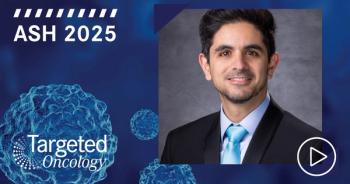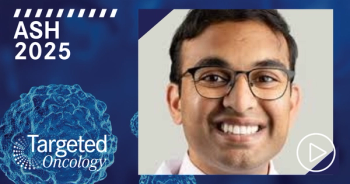
Targeted Therapies in Oncology
- October 2 2019
- Volume 8
- Issue 14
Treating ALL With Cellular and Targeted Immunotherapies Reduces the Need for Transplant
The advent of an era of targeted immunotherapy and CAR T-cell therapies for the treatment of adult patients with acute lymphoblastic leukemia may reduce the need for hematopoietic stem cell transplant in certain cases.<br />
Partow Kebriaei, MD
The advent of an era of targeted immunotherapy and CAR T-cell therapies for the treatment of adult patients with acute lymphoblastic leukemia (ALL) may reduce the need for hematopoietic stem cell transplant (HSCT) in certain cases.
“The best patient to go forward with transplant is that patient who is MRD [minimal residual disease] negative. As you go beyond first remission, the likelihood of achieving MRD negativity goes down,” said Partow Kebriaei, MD, professor in the Department of Stem Cell Transplantation in the Division of Cancer Medicine at The University of Texas MD Anderson Cancer Center in Houston, Texas, in an interview withTargeted Therapies in Oncology.Kebriaei joined Michael Pulsipher, MD, professor of pediatrics at the Keck School of Medicine of the University of Southern California and section head of Blood and Marrow Transplantation at Children’s Hospital Los Angeles, California, to present opposing views on the use of HSCT versus systemic therapies in certain patients with ALL at the Seventh Annual Society of Hematologic Oncology Meeting, held September 11 to 14, 2019, in Houston, Texas.1
Arguing against the use of HSCT, Pulsipher noted that risk stratification by MRD status, a prognostic factor for response, is one way to better determine whether patients are candidates for targeted immunotherapeutics (low risk) or cellular therapies (high risk). Other upfront approaches to decrease the need for HSCT, such as combinations of immunotherapies with chemotherapy backbones and CAR T-cell therapies, are currently being explored.1,2
Targeted Immunotherapeutics in Patients Ineligible for HSCT
Prior to the broad introduction of immunotherapies into the treatment paradigm of ALL, overall survival (OS) rates in adults 5 years after a first relapse were below 10%.3 The current rationale for treating ALL with immunotherapy is based on chemoresistance, treatment-related mortality due to factors such as bimodal disease incidence or advanced age, and improved response with the combined use of immunotherapies and chemotherapy.4
Novel therapies approved in the past 5 years have dramatically improved response rates for patients with relapsed/refractory ALL. Examples include the bispecific T-cell engager (BiTE) blinatumomab (Blincyto), the monoclonal antibody inotuzumab ozogamicin (Besponsa), and the first CAR T-cell therapies.4
In older patients with ALL, standard intensive chemotherapy approaches often result in lower response and higher toxicity than in younger patients.5 Prompted by the lack of optimal frontline therapy options for patients who are not good candidates for transplant, Pulsipher outlined studies suggesting benefits of targeted immunotherapies in this population.
Blinatumomab
Blinatumomab is a bispecific anti-body construct that targets both CD3 of the T-cell receptor complex and CD19, an antigen highly expressed on the surface of B cells, including ALL blasts. By transiently linking these 2 cell types, blinatumomab triggers T-cell activation, followed by T-cellmediated lysis of malignant B cells.4,6
Blinatumomab received accelerated approval in 2014 for the treatment of Philadelphia chromosomenegative (Ph-) relapsed/refractory B-cell precursor ALL, with subsequent trials confirming clinical benefit and leading to the 2017 expansion of the indication to include patients with Ph-positive disease.7In March 2018, the results of the BLAST trial led to the agent gaining accelerated approval for an additional indication: the treatment of patients with B-cell precursor ALL who are in first or second complete remission (CR) with MRD ≥0.1% (ie, with leukemic cells representing at least 0.1% of bone marrow cells according to highly sensitive, nonmorphologically based tests).8
In the phase II BLAST trial, patients ≥18 years with B-cell precursor ALL in first or later hematologic CR with persistent or recurrent MRD ≥0.1% following intensive chemotherapy were given blinatumomab with the option to undergo allogeneic HSCT. The primary endpoint was MRD response after 1 treatment cycle. Of 113 patients evaluable for response, 78% achieved a complete MRD response, with longer relapse-free survival and OS observed in these patients versus nonresponders.9
Consistent with prior literature and standard practices, 67% of patients treated in BLAST were offered HSCT, and transplant-related mortality was comparable to that in previous reports. There were 48 patients who remained in CR at the time of publication, of whom 36 had received HSCT.10
Interestingly, sustained remission was observed in a number of patients who did not receive transplant, confirming data from previous studies. This finding suggests that blinatumomab treatment may allow some patients, particularly those who are frail or elderly, to forgo harsher treatment strategies that include HSCT.11
Addition of Inotuzumab Ozogamicin
Inotuzumab ozogamicin is an antibodydrug conjugate (ADC) consisting of a derivative of the potent DNA-binding cytotoxic antibiotic calicheamicin linked to a humanized monoclonal IgG4 antibody directed against CD22, an endocytic receptor specific to B-cell malignancies.10Its mechanism of action involves binding to CD22 and releasing calicheamicin into tumor cells, which causes double-stranded DNA breaks and apoptosis.4
Inotuzumab ozogamicin was approved for the treatment of adults with relapsed/refractory B-cell precursor ALL based on the INO-VATE trial, which compared the single agent versus standard chemotherapy.11
Inotuzumab ozogamicin induced CR at a rate of 80.7% versus 29.4% (P<.001) in the control group. In addition, a higher percentage of patients in the inotuzumab ozogamicin group who achieved CR were also below the 0.01% threshold for MRD compared with the control group (78.4% vs 28.1%;P<.001).12
In an analysis of 135 patients ≥60 years with newly diagnosed Ph- ALL, 2 treatment programs were compared: the standard, intensive regimen of hyperfractionated cyclophosphamide, vincristine, doxorubicin, and dexamethasone (HCVAD); and a low-intensity regimen of mini-hyperfractionated cyclophosphamide, vincristine, and dexamethasone (mini-Hyper- CVD) plus inotuzumab ozogamicin with or without blinatumomab (TABLE).1 Higher response rates (98% vs 88%) and lower rates of early death (0% vs 8%) were seen with the ADC-mini- HCVD combination than with HCVAD. OS (63% vs 34%;P= .004) and event-free survival rates (64% vs 34%;P= .003) at 3 years also favored the combination. Few patients (≤5%) in either cohort went on to receive HSCT.5
“In the absence of randomized, prospective clinical trials, these results suggest that the combination is a superior frontline approach for older patients with Ph-negative ALL,” the study investigators concluded.
CAR T-Cell Therapies in Low-Burden Disease
Response rates of up to 90% have been reported in patients with B-cell ALL treated with CAR T-cell therapies,1 but many patients still proceed to transplant following remission.2 As these therapies become more prevalent, determining which patients can avoid allogeneic HSCT following response to therapy will be important for reducing transplant-related toxic effects.
In a study of 53 adult patients with relapsed B-cell ALL, treatment with 1928z CAR T cells (which target both CD19 and CD28) induced CR in 83%. Patients with a low disease burden (<5% bone marrow blasts) before treatment had markedly enhanced remission duration and survival.13
In the same cohort, 32 patients had MRD-negative CR, and some of these patients proceeded to allogeneic HSCT. Analyses of event-free survival and OS showed that there was no statistically significant benefit to transplant in these patients (P= .64 andP= .89, respectively).13
Areas Needing Further Investigation
A recent review of clinical trials of CAR T-cell treatment for ALL included a discussion of the use of HSCT in patients who achieve MRD-negative status following CAR T-cell therapy. Referring to the above study and a second trial showing a high rate of CD19-negative escape among patients who relapsed after HSCT, lead author Juanjuan Zhao, MD, said “this analysis argues that [allogeneic] HSCT may not effectively eliminate the CD19-negative ALL clones that evaded CAR T therapy. These observations suggest that additional graft-versus-leukemia effects may not be achieved by [allogeneic] HSCT following effective CAR T cell therapy.”14Kebriaei discussed challenges revealed during trials of CAR T-cell therapies. Better CAR T-cell persistence, improved toxicity profile, and prevention of CD19-negative escape are currently the most pressing areas of investigation, she said.1
Longer-term follow-up of these clinical trials has shown that CAR T cells generally persist for months, although long-term disease control has been observed only in patients who have proceeded to transplant. Kebriaei noted that persistence up to several years has been reported by investigators using CAR T cells with the 4-1BB costimulatory domain.
“In general, if a patient had a remission, and morphologic is adequate, and they are fit to undergo transplant, [then they meet the criteria] to go forward with transplant. What is happening now is that we are taking patients who may be on their third, fourth, or fifth line of therapy who, in the past, would not have been expected to have a response. Now these patients are attaining response, and we will take them to transplant because it does not matter that they have a response after their fifth line of therapy,” Kebriaei said.
References
- Kebriaei P, Pulsipher M. Is transplant still necessary in the era of targeted cellular therapy for ALL? Presented at: Seventh Annual Society of Hematologic Oncology Annual Meeting; September 11-14, 2019; Houston, TX.
- Kebriaei P. Debate: Transplant is still necessary in the era of targeted cellular therapy for ALL.Clin Lymphoma Myeloma Leuk. 2019;19 (suppl_1):S55 - S59.
- Fielding AK, Richards SM, Chopra R, et al; the Medical Research Council of the United Kingdom Adult ALL Working Party and the Eastern Cooperative Oncology Group. Outcome of 609 adults after relapse of acute lymphoblastic leukemia (ALL); an MRC UKALL12/ECOG 2993 study.Blood. 2007;109(3):944-950. doi: 10.1182/blood-2006-05-018192.
- Kebriaei P. Targeted immunotherapy for acute lymphoblastic leukemia. Presented at: Seventh Annual Society of Hematologic Oncology Annual Meeting; September 11-14, 2019; Houston, TX.
- Jabbour EJ, Sasaki K, Ravandi F, et al. Inotuzumab ozogamicin in combination with low-intensity chemotherapy (mini-HCVD) with or without blinatumomab versus standard intensive chemotherapy (HCVAD) as frontline therapy for older patients with Philadelphia chromosomenegative acute lymphoblastic leukemia: a propensity score analysis.Cancer. 2019;125(15):2579-2586. doi: 10.1002/cncr.32139.
- Goebeler ME. Knop S, Viardot A, et al. Bispecific T-Cell engager (BiTE) antibody construct blinatumomab for the treatment of patients with relapsed/refractory non-Hodgkin lymphoma: final results from a phase I study. J Clin Oncol. 2016;34(10):1104-11. doi: 10.1200/JCO.2014.59.1586.
- FDA grants regular approval to blinatumomab and expands indication to include Philadelphia chromosomepositive B cell. FDA website.
https://www.fda.gov/drugs/resources-information-approved-drugs/fda-grants-regular-approval-blinatumomab-and-expands-indication-include-philadelphia-chromosome . Published July 11, 2017. Accessed September 24, 2019. - FDA granted accelerated approval to blinatumomab (Blincyto, Amgen Inc.) for the treatment of adult and pediatric patients with B-cell precursor acute lymphoblastic leukemia. FDA website.
https://www.fda.gov/drugs/resources-information-approved-drugs/fda-granted-accelerated-approval-blinatumomab-blincyto-amgen-inc-treatment-adult-and-pediatric . Published March 29, 2018. Accessed September 24, 2019. - Gökbuget N, Dombret H, Bonifacio M, et al. Blinatumomab for minimal residual disease in adults with B-cell precursor acute lymphoblastic leukemia.Blood. 2018;131(14):1522-1531. doi: 10.1182/blood-2017-08-798322.
- Ricart AD. Antibody-drug conjugates of calicheamicin derivative: gemtuzumab ozogamicin and inotuzumab ozogamicin.Clin Cancer Res. 2011;17(20):6417-6427. doi: 10.1158/1078-0432.CCR-11-0486.
- FDA approves inotuzumab ozogamicin for relapsed or refractory B-cell precursor ALL. FDA website.
https://www.fda.gov/drugs/resources-information-approved-drugs/fda-approves-inotuzumab-ozogamicin-relapsed-or-refractory-b-cell-precursor-all . Published August 17, 2017. Accessed September 24, 2019. - Kantarjian HM, DeAngelo DJ, Stelljes M, et al. Inotuzumab ozogamicin versus standard therapy for acute lymphoblastic leukemia.N Engl J Med. 2016;375(8):740-753. doi: 10.1056/NEJMoa1509277.
- Park JH, Rivière I, Gonen M, et al. Long-term follow-up of CD19 CAR therapy in acute lymphoblastic leukemia.N Engl J Med. 2018;378(5):449-459. doi: 10.1056/NEJMoa1709919.
- Zhao J, Song Y, Liu D. Clinical trials of dual-target CAR T cells, donor-derived CAR T cells, and universal CAR T cells for acute lymphoid leukemia.J Hematol Oncol. 2019;12(1):17. doi: 10.1186/s13045-019-0705-x.








































